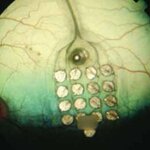Vision

Like the term 'junk DNA', the idea of 'primitive' reflexes is contextually confusing to some people outside biology. In reality, after millions of years of evolution, even a primitive reflex is sophisticated.
The Vestibular-Ocular Reflex (or VOR) is common to most vertebrates and allows us to keep our eyes focused on a fixed point even while our heads are moving. Researchers have assumed this reflex was controlled by the lower brainstem, which regulates eating, sleeping and other low-level tasks, thus the term 'primitive'. But researchers conducted tests to examine this reflex in left-…

Researchers have discovered 24 new genes that cause refractive errors and myopia, commonly known as short-sightedness.
During visual development in childhood and adolescence the eye grows in length but in myopes it grows too long, and light entering the eye is then focused in front of the retina rather than on it, resulting in a blurred image. This refractive error can be corrected with glasses, contact lenses or surgery. However, the eye remains longer, the retina is thinner, and this may lead to retinal detachment, glaucoma or macular degeneration, especially with higher degrees…
Last year, as our O2Amp technology got into the hands of more and more users (mainly interested in their various medical applications), we began hearing back from many color-blind folk.
One of our three technologies, they told us, gave them the surprising ability to distinguish reds and greens, exactly what their color-deficiency prevented them from seeing without our eyewear. In particular, the color-enhancing benefit came from our Oxy-Iso filter, which amplifies and isolates perception of oxygenation variations.
Although we didn’t design our technology with color-deficients specifically…

Our ability to imitate facial expressions depends on learning and visual feedback, say psychologists. Marketing people knew that already. The 'chameleon effect' is commonly used in interpersonal negotiations because imitating another person's postures and expressions is an important social lubricant.
How do we learn to imitate with accuracy when we can't see our own facial expressions and we can't feel the facial expressions of others?
In an experiment, the psychologists videotaped participants as they recited jokes and then asked them to imitate four randomly selected facial expressions from…

Branch retinal vein occlusion – blockage of the blood vessels that channel blood from the retina – is a common eye disease. A type of blood clot in the eye, the disease causes reduced vision, and people with the disease also typically have an increased risk of hypertension, diabetes and other serious conditions.
Mette Bertelsen from the University of Copenhagen and colleagues photographically verified the diagnosis of branch retinal vein occlusion in 1168 people.
The team of researchers at the University of Copenhagen, Glostrup Hospital and several other ophthalmology…

In wrestling, we were always taught to watch the opponent's hips - because their head and their eyes were going to try and fake you out but hips don't lie.
Likewise, if you think that you can use facial expressions to determine if someone has just won the lottery or lost everything in the stock market, researchers say it just doesn't work that way. Rather, they found that body language provides a better cue in trying to judge whether an observed subject has undergone strong positive or negative experiences.
In a new paper, psychologists showed that viewers in test groups were…

Psychologists from the University of Leicester have carried out eye tests to examine reading styles in young and old people and say there isn't just an eyesight issue - the way we read words changes as we grow older.
They digitally manipulated text, combined with precise measures of readers' eye movements, and say this provided new insight into how young and older adults use different visual cues during reading. Their experiments used precise measures of readers' eye movements to assess how well they read lines of text that had been digitally manipulated to enhance the salience of different…

A new device called the Argus II has been implanted in over 50 patients, many of whom can now see color, movement and objects and researchers have even streamed braille patterns directly into a blind patient's retina, allowing him to read four-letter words accurately and quickly with the ocular neuroprosthetic device.
Argus II uses a small camera mounted on a pair of glasses, a portable processor to translate the signal from the camera into electrical stimulation and a microchip with electrodes implanted directly on the retina.
Similar in concept to successful cochlear implants,…

Does gaydar exist? If so, it's in the eyes.
Sexual orientation can be revealed by pupil dilation to attractive people, say researchers who used a specialized infrared lens to measure pupillary changes of participants watching erotic videos. Pupils were pretty accurate: they widened most to videos of people who participants found attractive, thereby revealing where they were on the sexual spectrum from heterosexual to homosexual.Previous studies also tried to measure sexual orientation, but surveys are obviously useless and taking physiological measurements, like assessing genital…

Even if you are not aware of everything you take in, your eyes are sending visual information to your brain. This unconscious seeing is evidenced in a phenomenon called "blindsight", where people have no awareness, but their brains can see - even in subjects with visual impairment, caused by damage to a part of the brain called the visual cortex.
It has long been known that some patients with damage in the visual cortex, who cannot see, can still walk and avoid obstacles but that was nor proof they were using blindsight. A new study demonstrated that blindsight in…